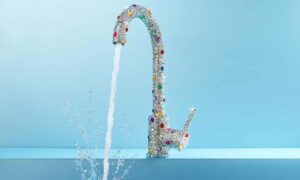
Towards the end of 2009, Camper English achieved a major breakthrough in his kitchen in San Francisco. After months of experimentation, English, a drinks industry consultant, created the perfect piece of clear ice: a cube with minimal fissures and microbubbles, as transparent as air.
His method for making clear ice – freezing water in an insulated container, which forces tiny bubbles towards the edge and leaves the rest of the block clear – is now widely copied in bars. English has also written The Ice Book: Cool Cubes, Clear Spheres, and Other Chill Cocktail Crafts, and has found his algorithmic niche as Instagram’s top “ice cube reporter”. He regularly shares pictures of bevelled spheres, ridged gems and crystalline pebbles on his account @alcademics, all tagged with #IceBling.
Directional ice cubes are the tip of the iceberg when it comes to aspirational water consumption in the 2020s. From water sommeliers offering tasting menus and artisanal water harvested from Svalbard glaciers to ionised water said to rebalance your body’s natural pH, it has become a fearsomely complicated business.
Water is the simplest thing we consume and perhaps the only one that is truly essential, since without it, life cannot exist. The fact that a quarter of the world does not have access to clean, fresh waterought to be a more urgent priority. But it seems there is something in our hypermodern capitalist mindset that simply cannot countenance a product so free, egalitarian – and boring. So we have to come up with ways of making even tap water aspirational, exclusive and, above all, expensive.
For some, even clear ice no longer cuts it. New York’s Bar Moga has taken to importing ice from Japan’s Mount Haku, more than 6,000 miles away. Whatever you think about the idea of shipping ice halfway across the world, there is a science to the use of ice in drinks. An old fashioned cocktail, for example, will benefit from a single large sphere, which will chill the drink with minimal dilution. A mint julep demands crushed ice, as cool fast-melting water is essential to the drink’s balance.
And yet it makes almost zero difference to the taste if that ice is tap water frozen in an old takeaway container (my preferred method) or a sliver of air-freighted Japanese glacier. The trend is, of course, driven by Instagram, where people like to post about their drinks of choice. “If social media didn’t exist, none of this would have happened,” English says.
I’m guessing you have acquired four or five insulated metal flasks in recent years? Leading manufacturer Chilly’s has just launched a TikTok campaign to try to reassert its dominance, which is interesting in itself: if the aim really was cutting down on waste, you’d think we’d all just need one of these things.
